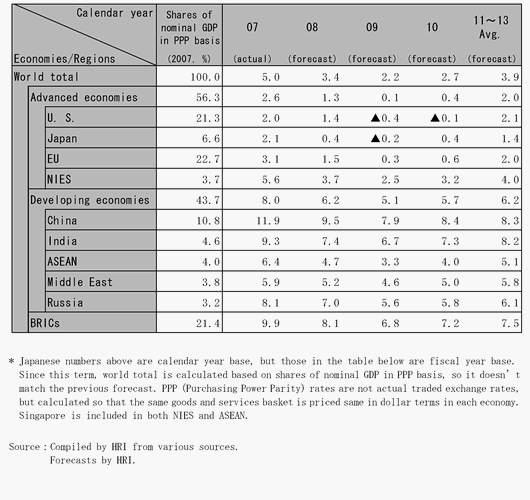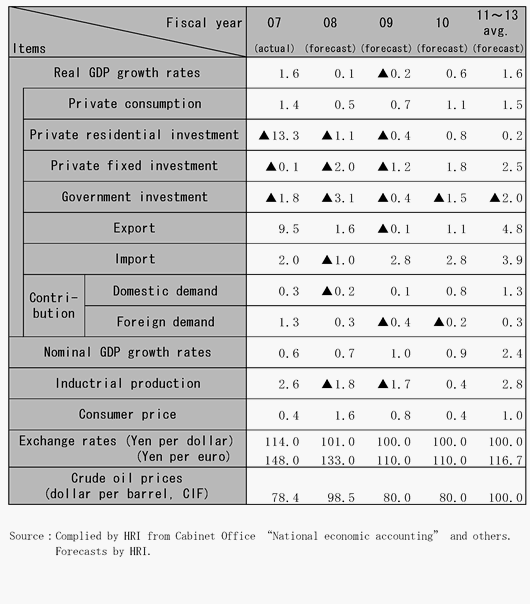Latest economic forecasts for Japan, the U.S., Europe, and China, etc
U. S. residential bubble burst has expanded into the first world financial crisis since 1930’s. Speculative money had flown out of financial markets into commodity markets since subprime-loan crisis popped up in the summer of last year, up to the summer of this year. Crude oil prices skyrocketed to 147 dollars per barrel on July 11. Rises in inflation rates slowed advanced economies down, then crude oil prices peaked out and fell sharply to 64 dollars per barrel on October 26, less than half of their peak. Meanwhile, U. S. house prices continued to fall. Fannie Mae and Freddie Mac, both government sponsored enterprises, were bailed out in August. Lehman Brothers, an investment bank, was not bailed out and went under in September, and then AIG, an insurance company, was bailed out. This financial crisis is now not only the problem of U. S., but also the problem of Europe and all other economies. Stock markets fell sharply one after another around the world. Short-term credit markets stopped their work in panic. Credit crunch is now everywhere. In currency exchange markets, the dollar strengthened, as fund managers began to sell overseas investments and to bring dollars back home. Only the yen strengthened sharply against the dollar, as the yen was believed to be safer currency remote from subprime-loan damages. World financial markets have stood still, watching out for another turmoil.
Governments in advanced economies responded to this crisis with unusual policies, like unrestricted supply of liquidity into short-term credit markets by central banks, equity injection of public money into banks, expansionary fiscal policy, etc. Policy interest rates go down substantially, as central banks have less fear on inflation. As these policies are implemented, financial markets will gradually begin to work again. One of the conditions to get out of this mess is the bottom-out of house prices in U. S. and Europe, which we forecast will occur in 2010. Meanwhile, credit crunch will continue to affect economies.
Under these circumstances, world economy cannot escape from world-wide concurrent recession. World total real GDP growth rates based on purchasing power parity rates will be 3.4% in 2008, 2.2% in 2009, and 2.7% in 2010, whose numbers less than 3%, which mean world recession. These numbers could turn out to be worse, if U. S. house prices fall more than our assumptions, or unexpectedly large bubble burst in Europe, or developing economies fall down one after another due to capital escape. If one of these risks becomes reality, the world economy may fall into deflation.
Wall Street expanded faster than Main Street thanks to credit boom in 2000’s, but it turns out to be unsustainable. Financial sectors have to shrink to appropriate size under credit crunch. U. S. over-consumption will no longer support the world effective demand. This adjustment is not cyclical but structural, and will take some time till 2010. Next effective demands will come from construction of new society, in which ecology friendly equipment and systems will bring low carbon emission, and multi-pillar powers will emerge, as developing economies will grow faster than developed economies.
U. S. economy deteriorated substantially in September when Lehman Brothers went bankrupt. Retail sales and non-agricultural employment decreased sharply. Recession is now inevitable. Real GDP growth rates will be negative in two or more consecutive quarters since July-Sept. U. S. real GDP growth rates will be 1.4% in 2008, -0.4% in 2009, and -0.1% in 2010. Recovery thereafter will be slow, as growth rates are under potential sustainable growth rates of nearly 3% until 2013.
The EU economy will also fall into recession, due to residential bubble burst and U. S. born financial crisis. EU real GDP growth rates will be 1.5% in 2008, 0.3% in 2009, and 0.6% in 2010.
Real GDP growth rates in China slowed down to 9.0% in July-Sept. in 2008, the first single digit rate since Oct.-Dec. in 2005. Decrease in exports to U. S. and sharp fall of stock and house prices implies recession even in China. So, as inflationary pressure eases, policy makers decided to change their courses from restriction to expansion in September. Chinese economy will change gears from too fast double digit growth to stable single digit growth of around 8%. Real GDP growth rates in China will be 9.5% in 2008, 7.9% in 2009, and 8.4% in 2010.
Commodity price surge in summer, and decrease in export due to overseas recession and stronger yen hit hard the Japanese economy. Corporate profits are squeezed, so investment will continue to decrease. Weak household income will lead to weak private consumption and residential investment. Government has decided 11.5 trillion yen emergency plan, in which 1.8 trillion yen will be included in central government supplementary budget. Government is now preparing the next supplementary budget, which is 5 trillion yen including 2 trillion yen of fixed amount payment per person. However, these government plans will not be effective enough to kick start the economy, as people tend to save money they receive from government due to anxiety for future. Real GDP growth rates in Japan will be 0.1% in fiscal year 2008, -0.2% in F. Y. 2009, and 0.6% in F. Y. 2010. In the longer term, domestic demand will get some support from income gains from overseas investments like infrastructure and ecology related investments in emerging economies and M&A investments in advanced economies.

